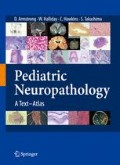Abstract
The cerebral surface develops gradually from the fetal flat (lissencephalic) brain to the adult gyral pattern, increasing the cortical surface area until the second year of life. The sylvian fissure is apparent at approximately 14 weeks’ gestation (GW). The primary sulci, such as rolandic, calcarine, superior temporal, and precentral sulci, appear after 20 GW, the secondary sulci appear from 28 GW, and the tertiary sulci from 36 GW. The gestational age of a brain can be estimated by counting the number of convolutions (gyri) crossed by a line drawn from the frontal to the occipital pole above the insula and adding 21 to the gyral count [1]. Gestational age can also be estimated by counting gyri and sulci in neuroimages [ultrasonography and magnetic resonance imaging (MRI)].
Access this chapter
Tax calculation will be finalised at checkout
Purchases are for personal use only
Preview
Unable to display preview. Download preview PDF.
1 Normal Development
Pryse-Davies J, Beard RW (1973) A necropsy study of brain swelling in the newborn with special reference to cerebral herniation. J Pathol 109:51–73.
Gilles FH, Levinton A, Dooling EC (1983) The developing human brain. John Wright, Boston, pp 117–183.
Sanes DH, Reh TA, Harris WA (2000) Development of the nervous system. Academic, San Diego.
Bayer S, Altman J (1991) Neocortical development. Raven, New York.
Rakic P (1972) Mode of cell migration to the superficial layers of fetal monkey neocortex. J Comp Neurol 145:61–84.
Conte JE, Golden JA, Kipps J, Zurlinden E (2004) Lis1 is necessary for normal non-radial migration of inhibitory neurons. Am J Pathol 16:775–784.
Deguchi K, Inoue K, Avila W, Lopez-Terrada D, Antalffy B, Quattrocchi CC, Sheldon M, Mikoshiba K, D’Arcangelo (2003) Reelin and Diabled-1 expression in developing and mature human cortical neurons. J Neuropathol Exp Neurol 62:676–684.
Brun A (1965) The subpial granular layer of the fetal cerebral cortex in man: its ontogeny and significance in congenital cortical malformations. Acta Pathol Microbiol Scand Suppl 179.
Ben-Arie N, Bellen HJ, Armstrong D, McCall A, Gordadze PR, Guo Q, Matzuk MM, Zoghbi HY (1997) Math1 is essential for genesis of cerebellar granule neurons. Nature 390:169–172.
Friede RL (1989) Developmental neuropathology. Springer, New York, pp 1–21.
Purpura DP (1975) Normal and abnormal neuronal development in the cerebral cortex of human fetal and young infant. In: Buchwald NA, Brazier MAB (eds) Mental retardation. Academic, San Diego, pp 141–169.
Sanes DH, Reh TA, Harris WA (2000) Development of the nervous system. Academic, San Diego.
Takashima S, Chan F, Becker LE, Armstrong DL (1980) Morphology of the developing visual cortex of the human infant: a quantitative and qualitative Golgi study. J Neuropathol Exp Neurol 39:487–501.
Back SA, Luo NL, Borentstein NS, Levine JM, Volpe JJ, Kinney HC (2001) Late oligodendrocyte progenitors coincide with the developmental window of vulnerability for human perinatal white matter injury. J Neurosci 21:1302–1312.
Hasegawa M, Houdou S, Mito T, Takashima S, Asanuma K, Ohno T (1992) Development of myelination in the human fetal and infant cerebrum: a myelin basic protein immunohistochemical study. Brain Dev 14:1–6.
Berry M, Butt AM, Wilkin G, Perry VH (2002) Structure and function of glia in the central nervous system. In: Graham DI, Lantos PL (eds) Greenfields’ neuropathology, 7th edn, Vol 1. Arnold, London, pp 75–123.
Hirayama A, Okoshi Y, Hachiya Y, Ozawa Y, Ito M, Kida Y, Imai Y, Kohsaka S, Takashima S (2001) Early immunohistochemical detection of axonal damage and glial activation in extremely immature brains with periventricular leukomalacia. Clin Neuropathol 20:87–91.
Takashima S, Becker LE (1983) Developmental changes of glial fibrillary acidic protein in cerebral white matter. Arch Neurol 40:14–18.
Takashima S, Tanaka K (1987) Development of cerebrovascular architecture and its relationship to periventricular leukomalacia in infancy. Arch Neurol 35:11–16.
Inage YW, Itoh M, Takashima S (2000) Correlation between cerebrovascular maturity and periventricular leukomalacia. Pediatr Neurol 22:204–208.
Rights and permissions
Copyright information
© 2007 Springer
About this chapter
Cite this chapter
(2007). Normal Development. In: Pediatric Neuropathology. Springer, Tokyo. https://doi.org/10.1007/978-4-431-49898-8_1
Download citation
DOI: https://doi.org/10.1007/978-4-431-49898-8_1
Publisher Name: Springer, Tokyo
Print ISBN: 978-4-431-70246-7
Online ISBN: 978-4-431-49898-8
eBook Packages: MedicineMedicine (R0)

